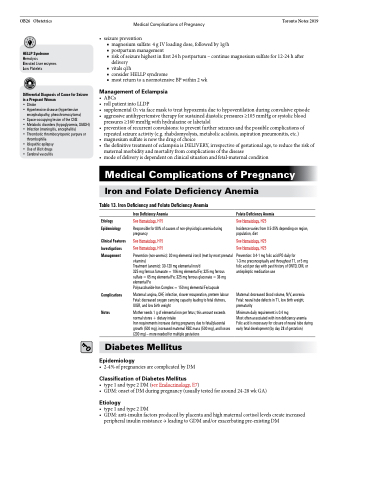Page 866 - TNFlipTest
P. 866
OB26 Obstetrics
Medical Complications of Pregnancy Toronto Notes 2019
• seizureprevention
■ magnesium sulfate: 4 g IV loading dose, followed by 1g/h
■ postpartummanagement
■ risk of seizure highest in first 24 h postpartum – continue magnesium sulfate for 12-24 h after
delivery
■ vitals q1h
■ consider HELLP syndrome
■ most return to a normotensive BP within 2 wk
Management of Eclampsia
• ABCs
• roll patient into LLDP
• supplemental O2 via face mask to treat hypoxemia due to hypoventilation during convulsive episode • aggressiveantihypertensivetherapyforsustaineddiastolicpressures≥105mmHgorsystolicblood
pressures ≥160 mmHg with hydralazine or labetalol
• preventionofrecurrentconvulsions:topreventfurtherseizuresandthepossiblecomplicationsof
repeated seizure activity (e.g. rhabdomyolysis, metabolic acidosis, aspiration pneumonitis, etc.)
• magnesium sulfate is now the drug of choice
• thedefinitivetreatmentofeclampsiaisDELIVERY,irrespectiveofgestationalage,toreducetheriskof
maternal morbidity and mortality from complications of the disease
• modeofdeliveryisdependentonclinicalsituationandfetal-maternalcondition
Medical Complications of Pregnancy
Iron and Folate Deficiency Anemia
HELLP Syndrome Hemolysis
Elevated Liver enzymes Low Platelets
Differential Diagnosis of Cause for Seizure in a Pregnant Woman
• Stroke
• Hypertensive disease (hypertensive
encephalopathy, pheochromocytoma)
• Space-occupying lesion of the CNS
• Metabolic disorders (hypoglycemia, SIADH)
• Infection (meningitis, encephalitis)
• Thrombotic thrombocytopenic purpura or
thrombophilia
• Idiopathic epilepsy
• Use of illicit drugs
• Cerebral vasculitis
Table 13. Iron Deficiency and Folate Deficiency Anemia
Etiology
Epidemiology
Clinical Features Investigations Management
Complications Notes
Iron Deficiency Anemia
See Hematology, H15
Responsible for 80% of causes of non-physiologic anemia during pregnancy
See Hematology, H15
See Hematology, H15
Prevention (non-anemic): 30 mg elemental iron/d (met by most prenatal vitamins)
Treatment (anemic): 30-120 mg elemental iron/d
325 mg ferrous fumarate = 106 mg elemental Fe; 325 mg ferrous sulfate = 65 mg elemental Fe; 325 mg ferrous gluconate = 36 mg elemental Fe
Polysaccharide-Iron Complex = 150 mg elemental Fe/capsule
Maternal: angina, CHF, infection, slower recuperation, preterm labour Fetal: decreased oxygen carrying capacity leading to fetal distress, IUGR, and low birth weight
Mother needs 1 g of elemental iron per fetus; this amount exceeds normal stores + dietary intake
Iron requirements increase during pregnancy due to fetal/placental growth (500 mg), increased maternal RBC mass (500 mg), and losses (200 mg) – more needed for multiple gestations
Folate Deficiency Anemia
See Hematology, H25
Incidence varies from 0.5-25% depending on region, population, diet
See Hematology, H25
See Hematology, H25
Prevention: 0.4-1 mg folic acid PO daily for
1-3 mo preconceptually and throughout T1, or 5 mg folic acid per day with past history of ONTD, DM, or antiepileptic medication use
Maternal: decreased blood volume, N/V, anorexia Fetal: neural tube defects in T1, low birth weight, prematurity
Minimum daily requirement is 0.4 mg
Most often associated with iron deficiency anemia Folic acid is necessary for closure of neural tube during early fetal development (by day 28 of gestation)
Diabetes Mellitus
Epidemiology
• 2-4%ofpregnanciesarecomplicatedbyDM
Classification of Diabetes Mellitus
• type1andtype2DM(seeEndocrinology,E7)
• GDM:onsetofDMduringpregnancy(usuallytestedforaround24-28wkGA)
Etiology
• type1andtype2DM
• GDM:anti-insulinfactorsproducedbyplacentaandhighmaternalcortisollevelscreateincreased
peripheral insulin resistance → leading to GDM and/or exacerbating pre-existing DM


